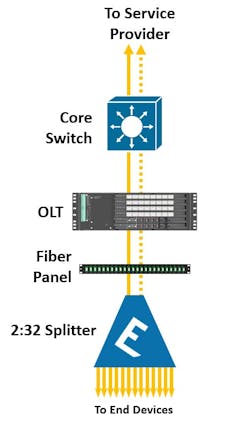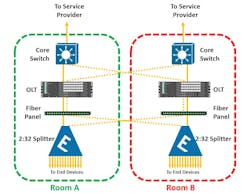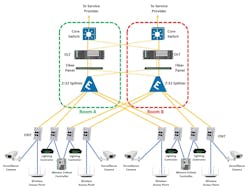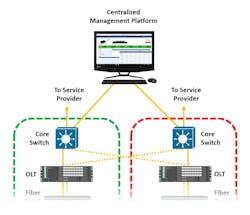How optical LANs deliver availability, security, and reliability with low cost and complexity
By Karen Leos
Today’s high-performance local area networks (LANs) deliver real-time services, ranging from typical voice, data, and video transmission for everyday business applications to an increasing range of building applications like surveillance, access control, LED lighting and building automation. Because enterprise businesses rely on LANs as the lifeline of their operations that connect real-time services, people, and devices across regional offices and international locations, they demand high LAN availability, security, and reliability. This is especially a concern as the cost of unplanned LAN downtime has risen drastically, increasing 32% in the past 7 years. According to ITIC’s 2022 Hourly Cost of Downtime Survey, the average hourly cost of downtime exceeded $300,000 for more than 90% of enterprises. According to the report, 44% of mid-sized and large enterprises indicate that a single hour of downtime can reach more than $1 million, with the hardest-hit industries including finance, entertainment, media, manufacturing, hospitality, transportation, healthcare, and retail.
Passive optical LANs have a solid reputation for reducing telecom room and pathway space, energy consumption, material, and maintenance for many enterprise businesses—all while supporting up to 10-Gigabit speeds over much longer distances than traditional switched LANs. However, with data transmitted from an optical line terminal (OLT) over a single strand of singlemode fiber through passive splitters, there is some misconception that redundancy, protection, and fault detection to achieve maximum availability, security, and reliability are not fundamental in passive optical LAN. But that couldn’t be farther from the truth. Resilient optical LANs are inherently secure and reliable, and they can achieve extremely high levels of availability via a combination of innovation and simple standards-based protection and design strategy.
Innovative reliability is vital
High levels of reliability are inherent in an optical LAN due to the fact that fiber provides better data transmission and security, and equipment is built upon “carrier grade” OLTs with simple, secure optical network terminals (ONTs) that have no local user interface and do not locally store user or configuration information. Modular chassis-based OLTs with redundant network cards, switch units, network uplinks, power inputs, and fans easily achieve “five-nines” (99.999%) availability. In the event of a network failure on one card, the ONT enables immediate fail-over and/or card swapping to ensure uninterrupted traffic flow for real-time and critical services. It also allows for the failed card to be replaced without affecting network availability.Another innovative OLT feature that improves reliability is PON path protection that uses standards-based spanning tree protocols to discover and monitor uplinks to core switches. Using PON path protection, OLTs can detect lost connectivity to a core switch and automatically shift traffic to another OLT rather than functioning as an isolated network with no connectivity to the service provider or wide area network (WAN). The automatic shift-in performed in less than 50 milliseconds, which is considered instantaneous for real-time applications.
Diverse fiber routes—first line of defense
For any LAN, the first line of defense is redundancy at core switches. This is typically achieved by connecting the core switch to the service provider network via two diverse fiber routes, or by deploying two disparate core switches that each connect to the service provider network, which is referred to as dual homing. Having two core switches also supports load balancing for efficient data transmission. Beyond the core, network redundancy and load balancing in a traditional switched network is achieved via primary and secondary aggregation switches connecting to each core switch, providing diverse fiber routes for data to continue transmitting in the event that one of the aggregation switches fails. Extending this redundancy throughout a traditional switched LAN to the edge requires racking, stacking, and cabling multiple switches in telecom rooms. All of that equipment and associated material adds unnecessary capital and operational costs, power, cooling, and space.
Diverse fiber routes can be easily deployed in an optical LAN, but without breaking the bank. Type B PON protection as defined by ITU-TG.984.1 GPON provides fiber route diversity via dual feed optical splitters (i.e., 2:X). This is achieved by connecting the two splitter feeds to separate ports or redundant cards deployed in an OLT with network health monitoring capabilities. A 2:X splitter is similar in cost to a 1:X splitter and introduces no additional optical loss, making this type of protection an easy decision for any optical LAN. To add more route protection, the dual fiber feeds to the splitter can reside in separate pathways to minimize the chance of both feeds being damaged or cut.
Geographically diverse OLTs: Peak reliability
While diverse fiber routing via Type B PON protection is considered best practice, the use of two OLTs further improves reliability and is customary practice among the majority of enterprise organizations. Referred to as Dual-Parented Type B PON protection in ITU-TG.984.1 standards, this scenario is achieved by connecting dual splitter feeds to two separate OLTs, allowing one OLT to take over control of the network in the event that the other is rendered out of service. Dual-Parented Type B PON protection combined with PON path protection also allows one OLT to take over control of the network if the other discovers that it has lost uplink connectivity.
While both OLTs can reside within the same telecom space, deploying them in two separate geographical locations with separate dual 2:X splitters is recommended in the event that one location is rendered out of service due to a power outage or catastrophic event such as a fire, earthquake, flood, or hurricane. To maintain high service availability for customers, FTTX PON deployments take this approach by placing two OLTs in separate central offices located in different geographic locations. In a campus environment, the two OLT locations could be at separate ends of the campus, while in a single facility they might be located at north and south or east and west sides of the building.While the critical nature of the services, cost of downtime, and/or the potential for natural disasters in a given geographic location are key decision factors, deploying geographically dispersed OLTs in conjunction with diverse fiber routing and advanced OLT redundancy features like, for example, Tellabs network health monitoring and PON path protection is a simple, cost-effective means of achieving “five nines” or better availability.
Strategic diversification design for mission critical
Building on the aforementioned Type B PON protection strategies, PON diversification is a strategic design approach for distributing connected devices and services across a facility to eliminate the chance of broad network outages and minimize any impact to critical services.
PON diversification can be achieved by interweaving ONT links from the dual 2:X splitters that connect to two geographically dispersed OLTs, thereby containing the impact of a Type B PON failover event to an interspersed mix of devices. This approach can be done based on service and/or location. For example, surveillance cameras and wireless access points for a given area can be connected to diverse splitters to eliminate any gaps in coverage. For highly mission-critical devices, PON diversification can also be achieved at the device level by connecting a device to two different ONTs that are served by diverse splitters for the mission-critical controllers. This allows the device to maintain operation if one of the ONTs fails or if there is a Type B PON failover. When used in conjunction with Dual-Parented Type B PON protection with geographically dispersed OLTs and fiber route diversity and innovative OLT redundancy features, a diversification design can provide “five nines” or better availability for mission-critical services.PON diversification is especially ideal for maintaining real-time services, such as security, patient care, or retail services. For example, in an airport where adjacent ticketing workstations are connected to diverse ONTs that connect to diverse splitters and OLTs, if one ticketing agent loses connectivity either due to ONT, card, or OLT failure, the adjacent ticketing agent can remain operational.
Centralized management facilitates it all
Achieving “five nines” or better availability in a switched network requires racking, stacking, and cabling multiple switches in telecom rooms that all need to be fully redundant via meshed cabling between them. Each switch also needs to be properly configured with the right security, access, control, and resource allocation policies. This is no easy task. In fact, misconfigurations in a typical switched network has emerged as the primary cause of downtime according to the Uptime Institute’s 2022 Annual Outage Analysis. In their 2021 Cyber Security Intelligence Index Report, IBM also reported that 95% of their security breaches were caused by human error, which were primarily equipment misconfigurations.
In contrast, optical LANs require far less configuration with system-wide intelligence centralized in the OLTs. The splitters are passive, unintelligent devices and the simple ONTs are exclusively controlled via the centralized OLT and do not locally store any configuration information. This makes an optical LAN far more secure and reliable, reducing the number of touch points on the network and preventing misconfigurations that can cause downtime.
With the inherent security of fiber, simple ONTs that have no local user interface, and a centralized management platform that resides on a single IP address, an optical LAN offers a Zero Trust Architecture (ZTA) as recommended by leading industry network security standards. This significantly reduces the cybersecurity attack surface compared to a switched network, which is critical in the face of rising global cybercrime that has increased nearly 300% over the past two years according to recent U.S. FBI reports. In addition, a centralized platform further reduces the potential for security breaches and misconfigurations via machine-to-machine actions and process consistency. For example, policy consistency is achieved through templates and profiles that are created in the management platform and distributed from OLTs to ONTs located across a campus, a region, a state, a country, or even in international locations. These global templates and profiles are used for provisioning traffic, bandwidth allocation, quality of service, remote power delivery, VLAN tagging, security, access-control policies, and other services at the user and device levels.
Enterprise use cases
Through the combination of innovative OLT redundancy features, standards-based PON protection, strategic design, and centralized management, optical LANs significantly reduce the cost and complexity of achieving “five nines” or better availability, security, and reliability compared to traditional switched LANs. While some may still be skeptical, the enterprise customers deploying the technology speak volumes to the resiliency of an optical LAN.
While reduced space, energy consumption, material, and maintenance are key drivers in the deployment of optical LANs, enterprise customers such as large hospitality and entertainment venues rely on the resiliency of optical LANs to avoid extreme downtime costs. The ability to cost-effectively achieve high levels of availability and inherent security has also made optical LANs the preferred network technology among government entities, including the United States Department of Defense. Mission-critical enterprise customers like hospitals and airports are also increasingly adopting optical LAN technology as a means to achieving the highest levels of availability, security, and reliability, while reaping the cost savings and sustainability benefits of reduced space, energy consumption, material, and maintenance.
Karen Leos is vice president of global sales and professional services at Tellabs, where she holds responsibility for the product, solution, and services portfolio through every phase in the lifecycle, from scoping and understanding customer needs through implementation, maintenance support, optimization, and refresh.





